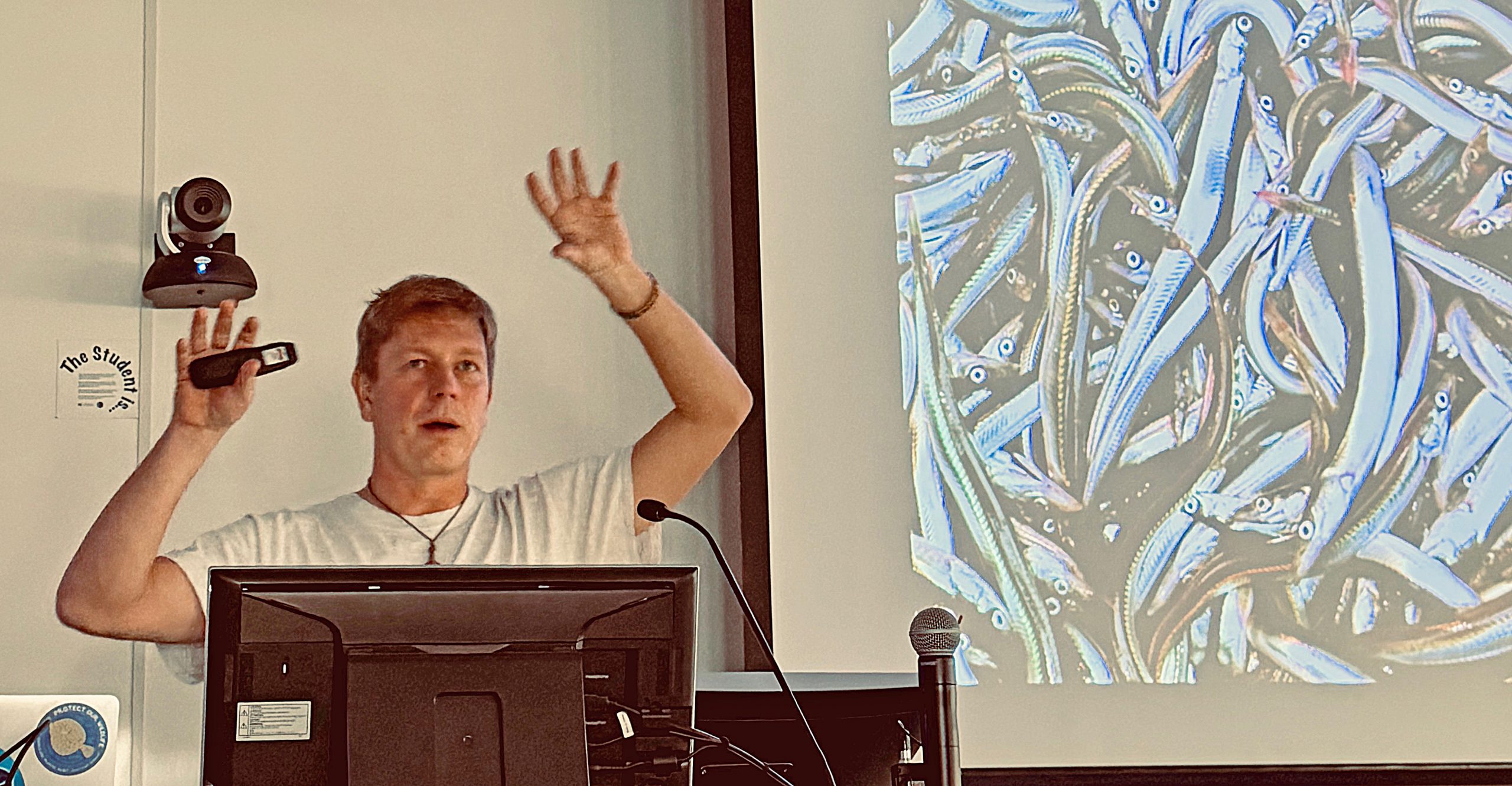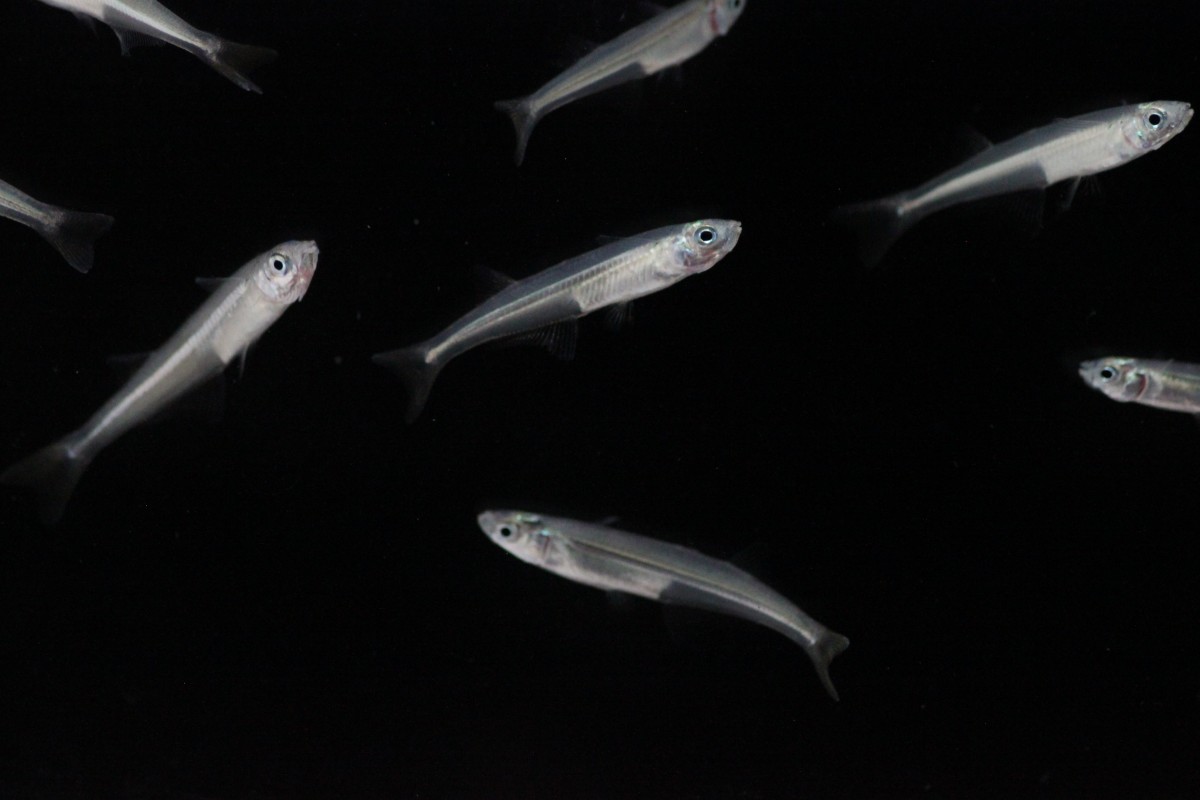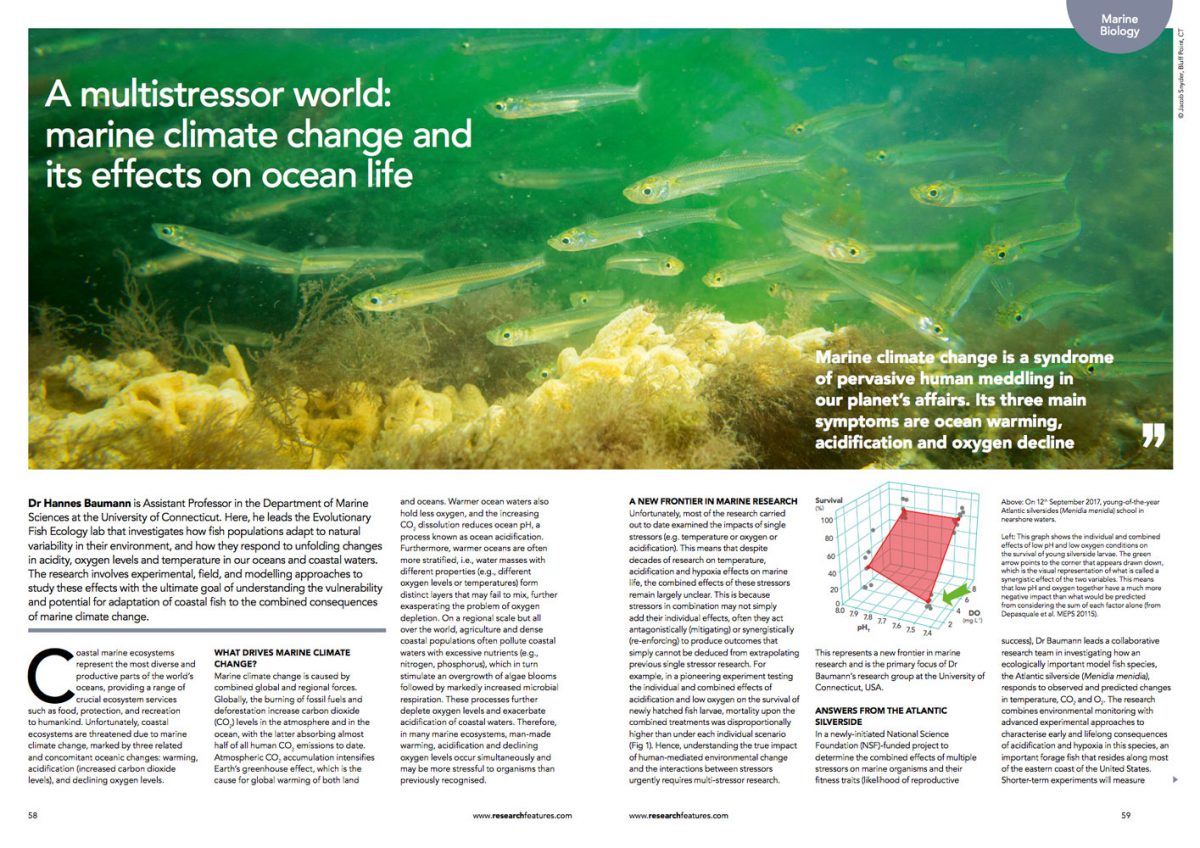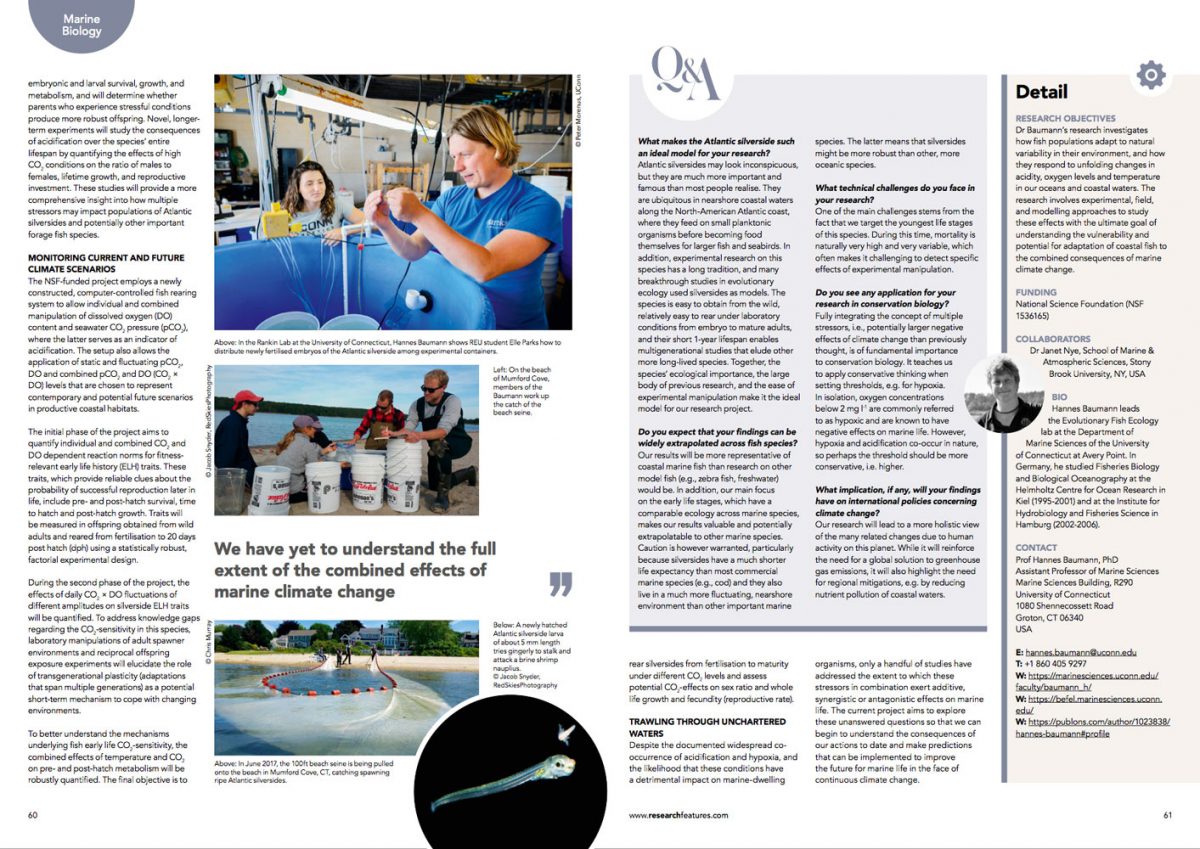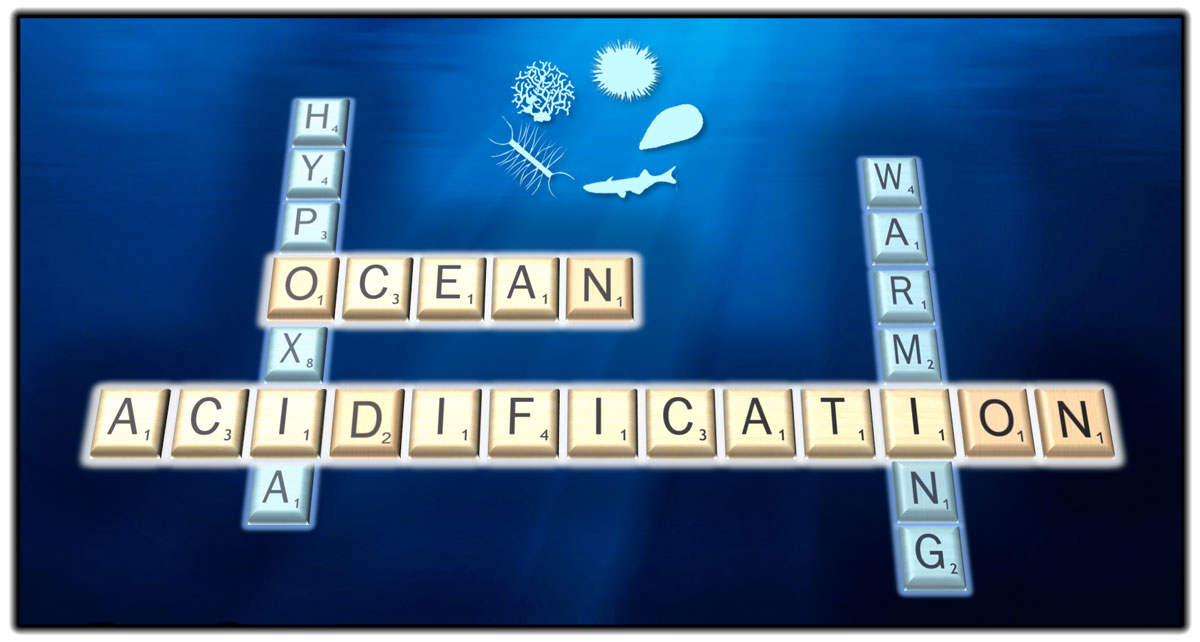American sand lance (Ammodytes americanus) swimming in surface waters of Wells Harbor, ME in November 2021
NSF-ORCC (Organismal Response to Climate Change): Collaborative Research: Mechanisms underpinning the unusual, high CO2 sensitivity of sand lances, key forage fishes on the Northwest Atlantic Shelf (2023-2026, $1,050,000)
*** Why are sand lance so sensitive to future high CO2 conditions in the ocean? ***
Public Award Abstract
Ocean warming and acidification are direct, predictable consequences of man-made climate change with likely vast but still insufficiently understood consequences for marine life.
So far, most tested fish species appear only mildly sensitive to ocean acidification, but sand lances are an exception. Sand lances are small, eel-like, schooling fishes of enormous importance as food for marine fish, seabirds and mammals in temperate to polar ecosystems, and recent research conclusively demonstrated that many sand lance embryos have trouble developing and hatching under predicted future ocean conditions.
This project uses modern experimental and molecular tools to understand exactly WHY sand lance embryos are so unusually sensitive and which genes and enzymes are responsible for this. Genes will also reveal whether some specific genotypes are less sensitive to warming and acidification, which can then be used to predict whether the species could evolve to be more tolerant over time. Another important objective is to test a closely related sand lance species to find out, whether the high climate sensitivity might be of general concern in this important group of forage fishes.
This project combines innovative ecological, evolutionary, and genomic research to help society anticipate looming marine ecosystem changes in the 21st century, while equipping the next generation of scientists with the needed tools and expertise to succeed in the challenges ahead.
The project also creates opportunities for high school students from underprivileged Connecticut schools to accompany the team on sand lance sampling trips to Stellwagen Bank National Marine Sanctuary.
Technical Award Abstract
Two recent studies on Northern sand lance (Ammodytes dubius), a key forage fish on offshore sand banks across the Northwest Atlantic shelf (NWA), have robustly demonstrated that predicted future CO2 conditions induce some of the most severe reductions in embryo survival and hatching success seen yet among tested fish species. This project has four objectives for revealing the mechanisms underpinning this unusual, high CO2-sensitivity as well as the ubiquity and genetic basis of this phenomenon. [1] For the first time, we will rear A. dubius offspring produced from wild spawners to late larval stages at factorial CO2 × temperature conditions to test whether sand lance larvae are as CO2-sensitive as embryos. [2] For the first time, we will use transcriptomic tools (RNAseq, RT-qPCR) to elucidate mechanisms causing ‘CO2-impaired hatching’, focusing specifically on hatching enzymes, to better understand a newly discovered mortality mechanism due to high CO2 in fishes. [3] Modern genomic approaches (low-coverage whole genome sequencing; allele frequency shifts, relatedness analyses) will reveal whether high CO2-sensitivity has a genetic basis in sand lance and could therefore evolve. [4] And for the first time, we will extend CO2 × temperature experiments to a congener, the American sand lance (A. americanus), which provides an important scientific contrast between nearshore vs. offshore species CO2-sensitivities and will yield critical insights whether high CO2-sensitivity is a wider concern within the sand lance family.
Active and past grants
- Baumann, H., Pacileo, D., Benway, J., and McBride, R.S. Increasing Black Sea Bass abundance in Long Island Sound: a local or broader regional phenomenon? Connecticut Sea Grant College Program R/LR-30.
- Baumann, H. and Nye, J. NSF-OCE #1536165: Collaborative research: Understanding the effects of acidification and hypoxia within and across generations in a coastal marine fish
- Baumann, H., Wiley, D. Kaufman, L., Valentine, P., and Gallager, S. Sensitivity of larval and juvenile sand lance Ammodytes dubius on Stellwagen Bank to predicted ocean warming, acidification, and deoxygenation. Northeast Regional SeaGrant Consortium
- Wiley, D., Kaufman, L., Baumann, H. and Llopiz, J. Productivity and ecology of sand habitats. Bureau of Ocean Energy Management (BOEM), interagency agreement with DOC/NOAA/OAR
- Dam, H., Baumann, H., Finiguerra, M., and Pespeni, M. Collaborative Research: Transgenerational phenotypic and genomic responses of marine copepods to the interactive effects of temperature and CO2. NSF-OCE #1550180 Project page
- Dam, H., Finiguerra, M., and Baumann, H. Predicting the performance of the copepod Acartia tonsa under future conditions of temperature and CO2. Connecticut Sea Grant College Program.
Selected publications
- Baumann, H., Jones, L.F.*, Murray, C.S., Siedlecki, S.A., Alexander, M., and Cross, E.L. (2022)
Impaired hatching exacerbates the high CO2 sensitivity of embryonic sand lance, Ammodytes dubius
Marine Ecology Progress Series 687:147-162 | UConn Today press release
- Concannon, C.A.*, Cross, E.L., Jones, L.F.*, Murray, C.S., Matassa, C. McBride, R.S., and Baumann, H. (2021)
Temperature-dependent effects on fecundity in a serial broadcast spawning fish after whole-life high-CO2 exposure
ICES Journal of Marine Science 78:3724–3734
- Suca, J., Wiley, D., Silva, T., Robuck, A., Richardon, D., Glancy, S., Clancey, E., Giandonato, T., Solow, A.R., Thompson, M.A., Hong, P., Baumann, H., Kaufman, L., and Llopiz, J.K. (2021)
Sensitivity of sand lance to shifting prey and hydrography indicates forthcoming change to the Northeast US shelf forage fish complex
ICES Journal of Marine Sciences 78:1023–1037
- Schwemmer, T.S., Baumann, H., Murray, C.S.*, Molina, A.I., and Nye, J. (2020)
Synergistic metabolic responses of embryos, but not larvae, of a coastal forage fish to acidification and hypoxia
Journal of Experimental Biology 223:jeb228015
- Murray, C.S.* and Baumann, H. (2020)
Are long-term growth responses to elevated pCO2 sex-specific in fish?
PLOS One 15:e0235817 | Press release | NSF news
- Cross, E.L., Murray, C.S.*, and Baumann, H. (2019)
Diel and tidal pCO2 × O2 fluctuations provide physiological refuge to a coastal forage fish
Scientific Reports 9:18146
- Murray, C.S.*, Wiley, D., and Baumann, H. (2019)
High sensitivity of a keystone forage fish to elevated CO2 and temperature
Conservation Physiology 7:1-12
- Baumann, H., Cross, E.L., and Murray, C.S. (2018)
Robust quantification of fish early life CO2 sensitivities via serial experimentation
Biology Letters 14:20180408
- Murray, C.S. and Baumann, H. (2018)
You better repeat it: complex temperature × CO2 effects in Atlantic silverside offspring revealed by serial experimentation
Diversity 10:69
- Gobler, C.J. and Baumann, H. (2016)
Hypoxia and acidification in ocean ecosystems: Coupled dynamics and effects on marine life
Biology Letters 12:20150976
- Baumann, H. (2016)
Combined effects of ocean acidification, warming, and hypoxia on marine organisms
Limnology and Oceanography e-Lectures 6:1-43
- Depasquale, E.*, Baumann, H., and Gobler, C.J. (2015)
Variation in early life stage vulnerability among Northwest Atlantic estuarine forage fish to ocean acidification and low oxygen
Marine Ecology Progress Series 523: 145–156
- Murray, C.M.*, Malvezzi, A., Gobler, C.J., and Baumann, H. (2014)
Offspring sensitivity to ocean acidification changes seasonally in a coastal marine fish
Marine Ecology Progress Series 504: 1-11 (Feature Article)
2015-2020: NSF-funded research on the sensitivity of coastal marine fishes to the combined stressors of acidification, hypoxia and warming (NSF-OCE #1536165)
NSF-OCE #1536165 | Public Outcomes Report
Concurrent ocean warming, acidification, and oxygen loss are symptoms of man-made marine climate change, but how marine organisms and their populations will react to these changes requires urgent investigation. Our project examined the climate sensitivity of an important model organism, the Atlantic silverside (Menidia menidia), a small, abundant forage fish in nearshore waters along the US east coast. Over 5 years, we conducted a comprehensive set of experiments, some as short as two weeks, some spanning more than a year. We systematically examined how this fish was affected by more acidic, meaning higher CO2 conditions – either alone or in combination with elevated temperature or lower oxygen levels.
To conduct many of these experiments, we engineered and built the ‘Automated Larval Fish Rearing System (ALFiRS)’ at the Rankin Seawater Lab of the University of Connecticut. It has a 3 x 3 design of nine independent rearing units, each with computer-control over their CO2, O2, and temperature levels. The units can even mimic diel or tidal CO2 x O2 fluctuations, which are very common in nearshore environments. To represent wild silverside populations, we started each experiment with embryos that were collected from a large number of adults collected by beach seine at a local field site (Image 1). In the laboratory, we focused on silverside traits that are known to determine Darwinian fitness, which is the success in contributing offspring to the next generation. This included measuring survival, length and weight growth, metabolism, sex ratios, fecundity and many other traits.
Like most organisms and especially fish, we found that silversides are most sensitive to predicted ocean acidification at their early life stages, meaning as unhatched embryos and very young larvae. The responses are highly variable, which is why we employed serial experimentation (n=20) to robustly quantify silverside early life CO2 sensitivity. This revealed an average 10% reduction in embryo survival under future CO2 conditions and a curious seasonal change in offspring CO2 sensitivity that is likely an adaptation of this species to seasonal changes in their productive nearshore habitat (Image 2).
We found complex interactions between temperature and CO2, where CO2 effects were often more pronounced at low or very high temperatures, while largely absent at optimal temperatures for this species. We found similar interactions with low oxygen conditions, which is important because high CO2 and low O2 conditions already co-occur seasonally in many coastal areas. These fluctuations are predicted to become more extreme in the future. Our research showed, however, that diel and tidal CO2 x O2 fluctuations appear to be beneficial to silversides and mitigated most effects seen under static conditions.
We also conducted a number of novel, long-term rearing experiments on silversides, demonstrating that juveniles grow up shorter under high CO2 conditions, while the fecundity of lab-matured females was largely unaffected by acidification. The findings of this project led to the development of the ‘Ocean Variability Hypothesis’ that emphasizes the role of natural CO2 variability in the environment for a species’ CO2 sensitivity – a contribution and attempt to synthesize the complexity of empirical data from a rapidly expanding field (Image 3).
In addition to its core foci, the project unearthed novel evidence for sex-selective survival of juvenile silversides in the wild (Image 4), quantified patterns in CO2 and O2 fluctuations in 16 estuaries across the US (Image 5), and contributed review and perspective articles to advance the scientific field. Nearly all published datasets are citable and publicly available from NSF’s BCO-DMO data portal as well as from other data repositories.
The project made a substantial, positive impact on the lives and careers of more than 20 people involved in it over 5 years. It supported the thesis research of three Master students, one PhD student, and one post-doctoral researcher. It mentored three consecutive NSF-REU students and their research projects and inspired over 15 undergraduate students working or volunteering for the project (Image 6). The project succeeded in capacity building for hands-on skills like fish sampling and fish husbandry, for conducting accurate water chemistry measurements and effectively analyzing, visualizing, and publishing research data. Apart from peer-reviewed publications and conference presentations, we brought our findings to the general public via community college lectures, open-house demonstrations, blogs, brochures and on social media. Funding from this NSF-project has greatly helped with upkeeping and updating the Rankin Seawater Lab as a valuable and shared resource for the university community.
- Baumann, H. (2016) Combined effects of ocean acidification, warming, and hypoxia on marine organisms
Limnology and Oceanography e-Lectures 6:1-43


